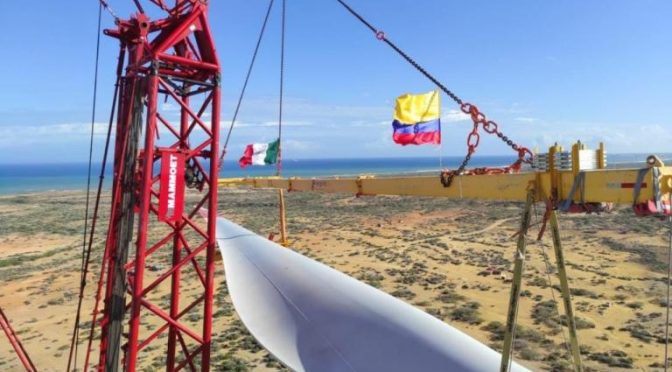In the municipality of Uribia, in La Guajira, President Iván Duque inaugurated a few days ago, with the presence of representatives of the Wayúu community, the second wind farm in the country, a project that will generate twenty megawatts, enough to supply energy to more than thirty thousand homes.
Its entry into operation is of great significance because it is the first of the second generation to be built, after more than fifteen years, when EPM launched the Jepírachi pilot project in 2004, also in Uribia, with an installed capacity of 19.5 megawatts. The fifteen wind turbines, with their towers and poles moving in the middle of the desert to catch the strong wind that blows in the area and convert it into energy, formed part of the landscape and were a solitary symbol of non-conventional renewable energies, whose development had remained in we will see.
But now, with this new project built by Isagen, Guajira I, wind energy is taking off in Colombia. In a row are another fifteen more projects of this nature, with private investments close to ten billion pesos, of which the Alpha and Beta parks are part, with ninety wind turbines and five hundred megawatts, which are equivalent to the energy consumption of more than eight hundred thousand families.
These projects and those that are on the way will be built in La Guajira, called to become an energy hub, and begin to make this government’s commitment to face climate change with cleaner energy a reality.
The department, with its privileged location, is ideal for the development of unconventional energies, such as wind and solar, thanks to the power of its winds and its strong solar radiation. According to the Ministry of Mines and Energy, the wind speed is twice the world average and the radiation is 60% higher than that recorded in other regions of the planet. That is why the investments for these energies will be concentrated in this area and in several departments in the north of the country, such as Cesar, Magdalena and Bolívar.
Non-conventional renewables are becoming a revolution of wind and sun, if one takes into account that until three years ago they were equivalent to less than 1% of installed capacity. Although Colombia has one of the cleanest energy matrixes in the world, since 70% of the generation is hydroelectric and about 30% is thermal, the government expects that by the end of this year the participation of non-conventional companies will reach 16 %, with more than 2,500 megawatts installed. In this way, it would diversify its sources of energy generation and advance in the objective of reducing polluting emissions by 51% by 2030.
While wind farms begin to take off, solar energy farms number in the dozens. From small initiatives to bring energy to factories or homes to large parks and solar farms, such as those built by Celsia, Enel Green Power and Ecopetrol, among others, have been inaugurated. Currently, Colombia has two wind farms (Jepírachi and Guajira I), seventeen solar farms, ten large-scale self-generation projects and more than two thousand five hundred small-scale self-generation solar projects.
Yesterday, for example, President Iván Duque and his minister Diego Mesa inaugurated the La Sierpe solar farm, in the wetlands of Sucre, with more than sixty-five thousand state-of-the-art panels, which generate twenty-six megawatts and serve to reduce eighteen thousand tons of CO2 per year.
Although Colombia fully entered into non-conventional renewables, in which it was far behind Chile or Brazil, it must overcome difficulties related in large part to delays in prior consultations with the indigenous peoples of the territories through which these projects will pass. An example is the construction of Colectora, a four hundred and eighty kilometer transmission line and three substations, in charge of Grupo Energía Bogotá, vital to incorporate the energy that will be produced in those wind power and solar parks into the National Transmission System. Without this project, which must go through a consultation process with more than two hundred ethnic communities, the energy will be trapped without being able to be distributed to other parts of the national geography.
To this is added that La Guajira, and in general the departments of the Atlantic coast, face social problems due to high poverty, inequality, lack of efficient public services and corruption that has entrenched itself and slows its development. The communities hope that the arrival of these projects will generate progress, sources of employment and improvements in living conditions. It is a task in which the private sector and government must work hand in hand. It would not be fair to see towers, cables and solar cells everywhere if the communities do not have energy or live in misery. The energy revolution is a great opportunity.


